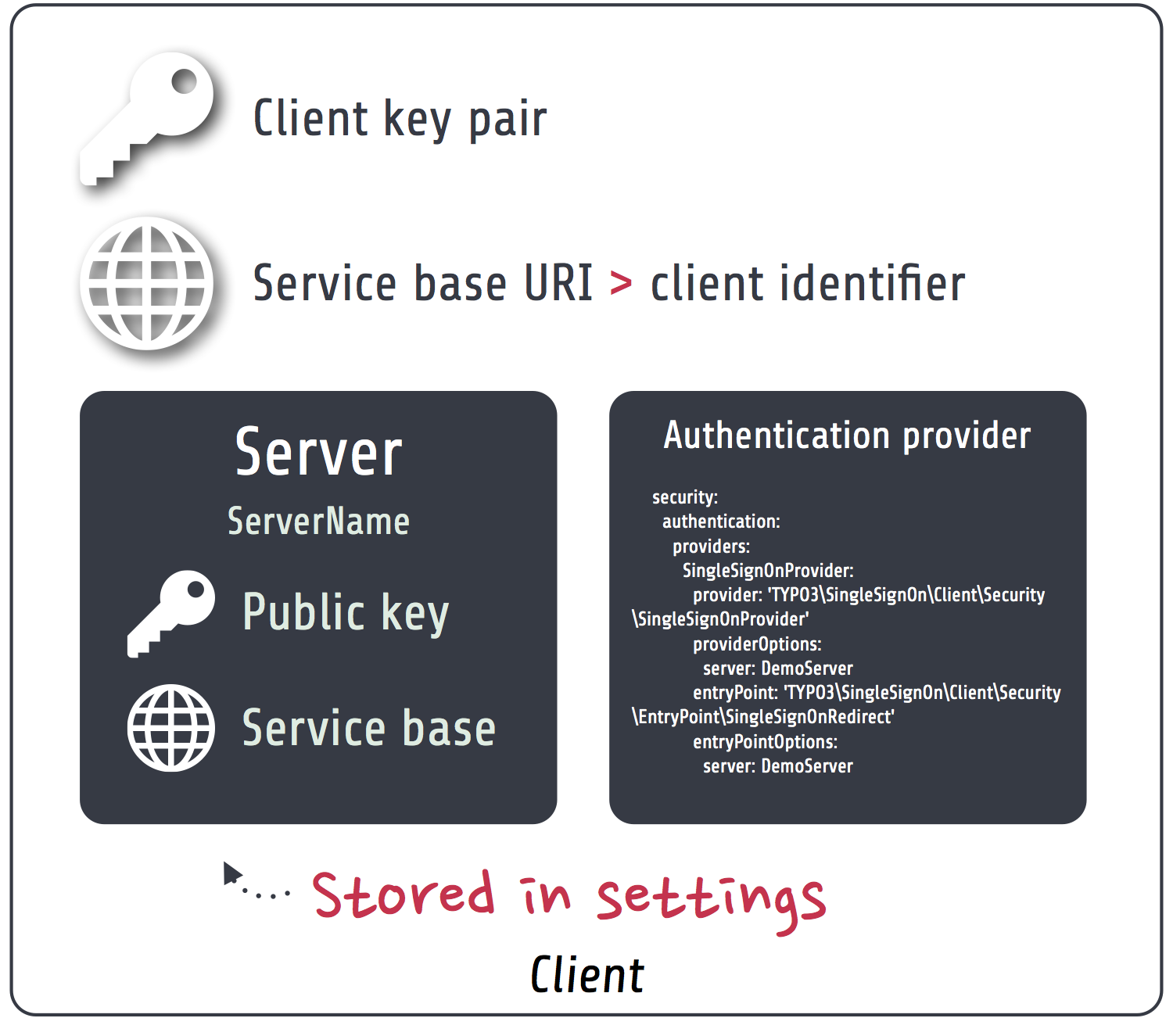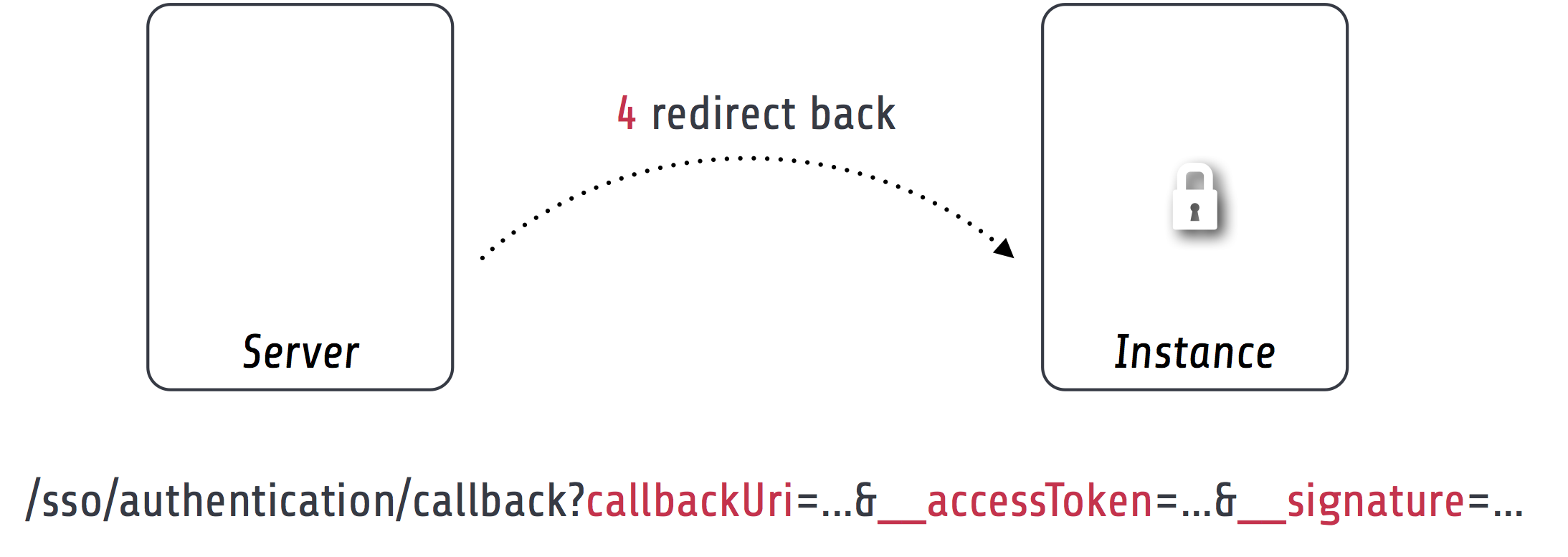Single sign-on client¶
The Flowpack.SingleSignOn.Client package is needed on any instance that should participate in the single sign-on process. It can be installed in any TYPO3 Flow (> version 2.x) application and configured through the security framework.
No special requirements exist for an application to become a single sign-on instance, except that it should be reachable by the server for the server-side requests (e.g. for Client notification). Furthermore the client does not require any persistence storage (besides the default Flow session) or database access.
Components¶
This is a schematic view of the single sign-on client components that are part of a TYPO Flow application which is called an instance.

- Client key pair
- The client has a public / private key pair for encryption and request verification. The public key is shared with all servers that are used by the client (most of the time there will be only one server).
- Service base URI
- The client exports HTTP services on a specific URL path. This path acts as the Service base URI (e.g. http://ssoinstance.local/sso/) or client identifier. It is used to register the client on the server.
- Servers
- The client configuration has a list of servers that could be used for the actual authentication provider options. From an architecture point of view it’s possible to use different single sign-on servers in the same application, although that should be a rare use-case.
- Authentication provider and entry point
- The client package provides a special SingleSignOnProvider authentication provider and SingleSignOnRedirect entry point which have to be configured in the TYPO3 Flow security framework for the single sign-on to be used as the authentication method. See Configuration / Authentication.
Installation¶
Installation of the single sign-on client package should be done via Composer:
$ path/to/composer.phar require flowpack/singlesignon-client
Note
If you extend the client package or want to provide configuration in a custom package you should add the flowpack/singlesignon-client composer package as a dependency of that package for correct initialization order.
Configuration¶
Package configuration¶
The Flowpack.SingleSignOn.Client package provides the following default configuration:
Flowpack:
SingleSignOn:
Client:
# SSO client configuration
client:
# The client service base URI as the client identifier
# Must point to the URI where the SSO client routes are mounted
serviceBaseUri: ''
# The client key pair fingerprint
publicKeyFingerprint: ''
# A list of named SSO server configurations
server:
# Example server configuration
#
# DemoServer:
# publicKeyFingerprint: 'bb5abb57faa122cc031e3c904db3d751'
# serviceBaseUri: 'http://ssoserver/sso'
accountMapper:
# Map a party type from the server to the instance, more complex scenarios
# need a specialized account mapper implementation (see GlobalAccountMapperInterface)
#
# typeMapping:
# 'Vendor\MyServer\Domain\Model\SomeParty': 'Vendor\MyApplication\Domain\Model\OtherParty'
#
typeMapping: []
log:
# Enable logging of failed signed requests (signature verification errors)
logFailedSignedRequests: FALSE
| Option | Description | Mandatory | Type | Default |
|---|---|---|---|---|
| client.serviceBaseUri | The service base URI for this client | Yes | string | |
| client.publicKeyFingerprint | Key pair fingerprint for the client | Yes | string | |
| server | Array of named server configurations, server name (not identifier) as the key | Yes | array | |
| server.ServerName.publicKeyFingerprint | Public key fingerprint of the server | Yes | string | |
| server.ServerName.serviceBaseUri | Service base URI of the server | Yes | string | |
| accountMapper.typeMapping | Party type mapping from server to client for SimpleGlobalAccountMapper | No | array | |
| log.logFailedSignedRequests | Controls logging of failed signed requests via an aspect (for debugging) | No | boolean | FALSE |
Note
The package also configures some settings for TYPO3 Flow. For the signed requests a security firewall filter with the name ssoClientSignedRequests is configured. This filter can be modified or removed in another package configuration or global configuration.
Authentication¶
The client has to be configured as an authentication provider on the instance to use a server for the single sign-on.
TYPO3:
Flow:
security:
authentication:
providers:
SingleSignOnProvider:
provider: 'Flowpack\SingleSignOn\Client\Security\SingleSignOnProvider'
providerOptions:
server: DemoServer
globalSessionTouchInterval: 60
entryPoint: 'Flowpack\SingleSignOn\Client\Security\EntryPoint\SingleSignOnRedirect'
entryPointOptions:
server: DemoServer
This example configuration configures an authentication provider with name SingleSignOnProvider (this can be chosen freely) that uses a single sign-on server configured in Flowpack.SingleSignOn.Client.server.DemoServer. The entry point SingleSignOnRedirect needs to be registered for the single sign-on to intercept unauthenticated requests to secured resources (e.g. policy restriction of a controller action) and continue after the session is transferred from the server.
The globalSessionTouchInterval is a provider level option that configures the amount of seconds that can pass without touching the global session on the server (see Session synchronization).
Routes¶
The routes of the client package have to be registered in the global Routes.yaml:
##
# Flowpack.SingleSignOn.Client subroutes
#
-
name: 'SingleSignOn'
uriPattern: 'sso/<SingleSignOnSubroutes>'
subRoutes:
SingleSignOnSubroutes:
package: Flowpack.SingleSignOn.Client
The path sso/ can be freely chosen but will be part of the client service base URI that needs to be used for Client registration.
Commands¶
ssokey:generatekeypair¶
The client package provides a ssokey:generatekeypair command to create a new public / private key pair (usable for client or server):
Generate key pair command
COMMAND:
flowpack.singlesignon.client:ssokey:generatekeypair
USAGE:
./flow ssokey:generatekeypair
DESCRIPTION:
Creates a new key pair and imports it into the wallet.
Used by SSO client and server.
Example:
$ ./flow ssokey:generatekeypair
Created key with fingerprint: ee60cb20fab84db9136903e107657b7f
The returned hash is the public key fingerprint of the created key pair.
Note
The generated private key is unencrypted and should be kept secretly (the keys are stored in the RsaWallet by default in Data/Persistent/RsaWalletData).
ssokey:exportpublickey¶
The server and client need the full public key from either side. This can be done by exporting the public from a key pair on the server or instance and importing it on the other side by using the core command security:importpublickey. For the export of a public key the client package ships a ssokey:exportpublickey command:
Export a public key
COMMAND:
flowpack.singlesignon.client:ssokey:exportpublickey
USAGE:
./flow ssokey:exportpublickey <public key fingerprint>
ARGUMENTS:
--public-key-fingerprint
Example:
Generating a key pair for the single sign-on client on an instance:
$ cd path/to/instance
$ ./flow ssokey:generatekeypair
Created key with fingerprint: ee60cb20fab84db9136903e107657b7f
$ ./flow ssokey:exportpublickey ee60cb20fab84db9136903e107657b7f > instance.pub
Importing the key for the client on the server (needs file instance.pub on the server):
$ cd path/to/server
$ ./flow security:importpublickey < instance.pub
The public key has been successfully imported. Use the following uuid to refer to it in the RSAWalletService:
ee60cb20fab84db9136903e107657b7f
Authentication callback¶
The client exposes a public action for authentication callback that accepts a request from the server after the authentication on the server for the single sign-on was successful. The request contains query arguments for the callbackUri, a server generated encrypted Access token and a signature over the arguments for verification.

To verify the authenticity of the request the signature is checked against the public key of the configured server and the access token is decrypted with the client private key. The next step is the Access token redemption with a server-side signed request from the instance to the server.
Account mapping¶
The server will respond with the account data of the authenticated account in the global session that is prepared through account mapping on the server.

The client needs to map this data to a local account with a GlobalAccountMapperInterface implementation:
interface GlobalAccountMapperInterface {
/**
* @param \Flowpack\SingleSignOn\Client\Domain\Model\SsoClient $ssoClient
* @param array $globalAccountData
* @return \TYPO3\Flow\Security\Account
*/
public function getAccount(
\Flowpack\SingleSignOn\Client\Domain\Model\SsoClient $ssoClient,
array $globalAccountData
);
}
A default implementation of this interface is shipped in the client package with the class SimpleGlobalAccountMapper that will be used by default.
SimpleGlobalAccountMapper¶
This global account mapper implementation expects the account data in a schema that matches the SimpleClientAccountMapper on the server:
Example account data:
accountIdentifier: 'jdoe'
roles: ['Vendor.MyPackage:User']
party:
__type: 'Vendor\MyPackage\ExampleParty'
company: 'Acme Inc.'
The account mapper will instantiate a new Account instance that is transient and should not be persisted as for every single sign-on process a new Account will be created. If the authenticated account needs to be referenced by other domain models a custom global account mapper implementation has to be created that could create new persisted accounts lazily and update their data according to the given account data. Because this is very domain specific we do not ship a default implementation for this mapping strategy.
The party type is given as the key party.__type and will be mapped to a type on the instance using the Flowpack.SingleSignOn.Client.accountMapper.typeMapping setting. This setting allows to have a simple one-to-one mapping between classes on the server and on the instance. The property names in the account data have to match for the default implementation.
Logging¶
The client package performs no special logging besides a logging aspect for signed request debugging. The aspect to log failed signed requests with signature verification errors can be enabled via the Flowpack.SingleSignOn.Client.log.logFailedSignedRequests setting. The requests are logged to the Flow security logger.
HTTP services¶
This is a list of all HTTP services (controller actions) that are exposed by the client. The URI path depends on the global Routes.yaml that mounts the package subroutes, we expect the routes to be mounted at /sso/<SingleSignOnSubroutes>.
Public¶
- /sso/authentication/callback
- Route for the authentication callback, has to be accessible for all users that should authenticate using the single sign-on.
Private¶
The controller for these routes are protected by a signed request firewall filter and should only be accessible by a single sign-on server. We strongly suggest to take additional measures for securing the server-side channel between the server and instances (e.g. SSL with client certificates, firewall rules, additional request filter).
Warning
The default TYPO3 Flow routes could allow access to controller actions even though the URI paths are secured by a firewall or webserver configuration.
- /sso/session/{sessionId}/destroy
- Route for the Client notification to destroy the local session on an instance when a user logs out on another instance or the server.